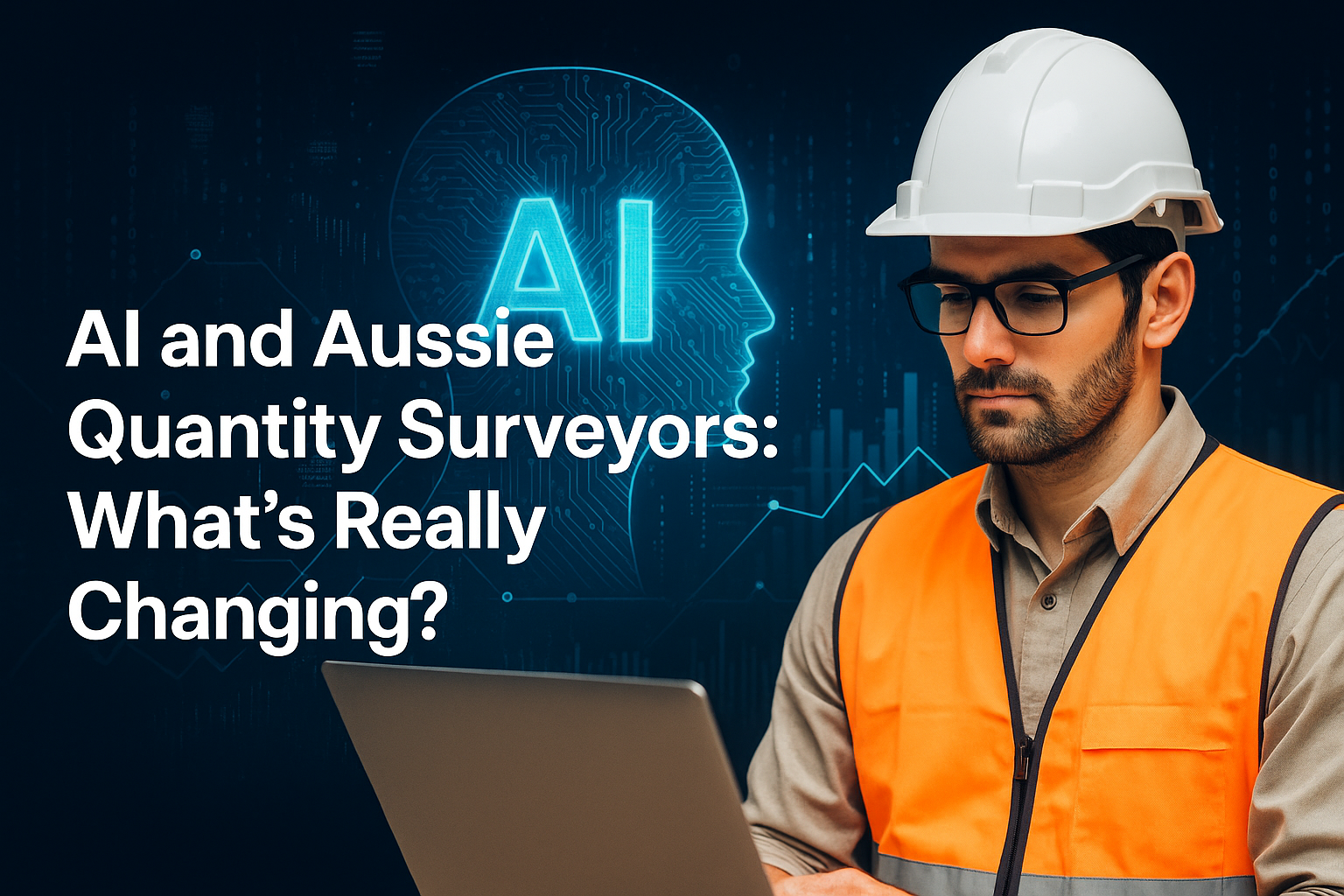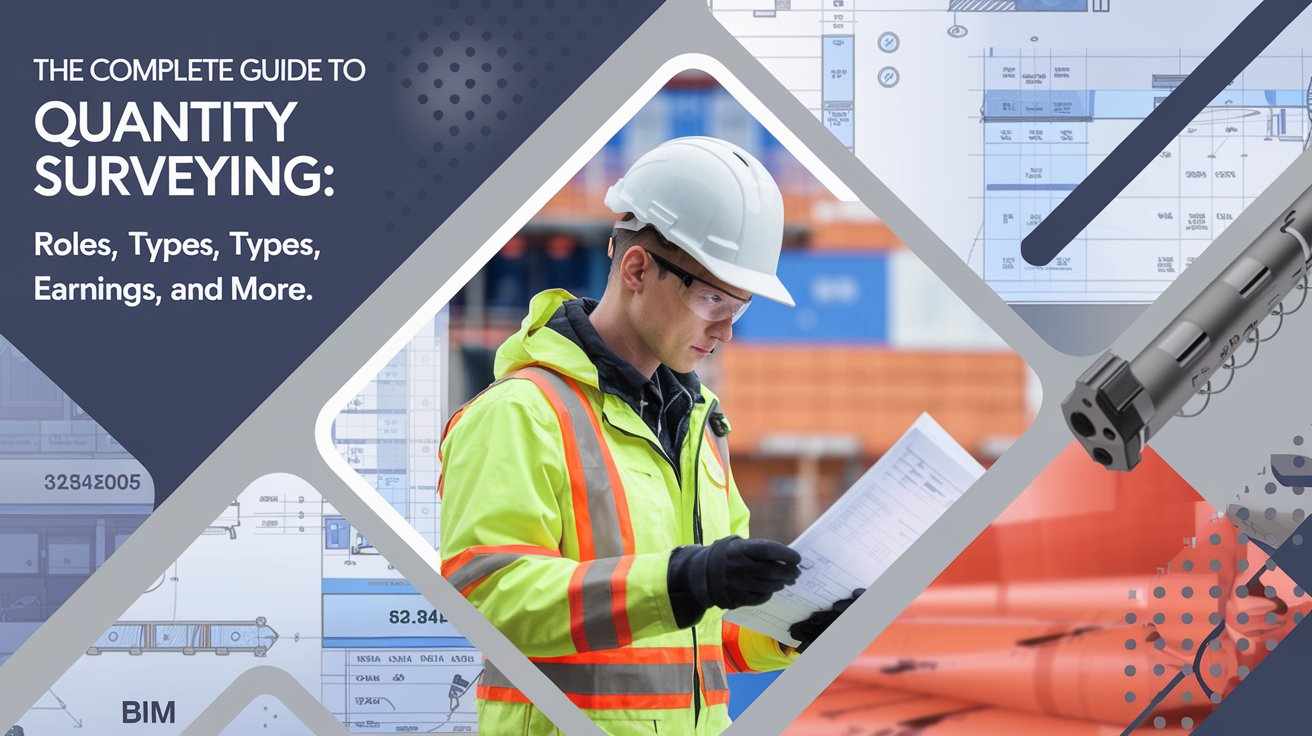
Alright, let's talk about Artificial Intelligence (AI) and how it's shaking things up for quantity surveyors (QSs) here in Australia. You know, the folks who keep construction projects from going wildly over budget? Well, AI is stepping onto the scene, and it's changing the way they work – automating stuff, making things more accurate, and bringing in some pretty cool new tools.
Get this: about 30% of Aussie construction companies are already playing around with or using AI in 2024, and another chunk are planning to jump in soon (LinkedIn Pulse). That's a big shift. So, let's dig into how AI is actually tweaking the job of a quantity surveyor down under.
First Up: What Do Quantity Surveyors Usually Do?
Think of quantity surveyors as the cost experts for building projects. Traditionally, their job involves figuring out how much things will cost, setting budgets, getting tender documents ready, managing contracts, and keeping track of the finances all the way through (Australian Institute of Quantity Surveyors).
As the Australian Institute of Quantity Surveyors (AIQS) puts it, they handle the costs for everything from giant stadiums and tunnels to universities and houses (AIQS). They're crucial players, working from the first idea right until the project's finished.
The Aussie Construction Scene
Our construction industry is huge, employing over 1.3 million people. But it's got its headaches – not enough skilled workers, trouble getting materials, and supply chains being a bit wonky. Still, businesses pulled in an average of AUD $142 million last financial year and expect things to grow (1Breadcrumb).
Historically, construction hasn't been the quickest to grab onto new tech. But recent pressures are pushing things along. Now, the average business uses about 5 different technologies, and bigger companies use even more (1Breadcrumb). AI is becoming part of that mix.
How AI is Being Used Right Now
So, where is AI actually making a difference for quantity surveyors today?
Automating Measurements (Quantity Takeoff):
One of the big, time-consuming jobs for a QS is measuring everything needed for a project from blueprints or models. It's called quantity takeoff. AI is now automating chunks of this. Instead of manually clicking and measuring for hours, AI tools can scan digital plans or BIM models and pull out the quantities needed. Software like Togal.AI does this automatically (Togal.AI), and others like Kreo 2D Takeoff use AI to auto-measure, count items, and even suggest things (RICS). This frees up QSs from tedious work and makes things way faster and more consistent.Smarter Cost Estimates:
Guessing costs accurately is tough. AI helps by crunching huge amounts of past project data – things like materials, labor costs, location – to predict future costs much more reliably (Altus Group). As the folks at Cost Logic say, AI cost estimation software is a "game-changer" because it learns from data and adapts to the specifics of each new project (Cost Logic). It's less about relying on gut feelings or slightly old cost books and more about data-driven insights.Digital Twins for a Clearer Picture:
We've talked about digital twins before – those live virtual copies of projects. Aussie firms like WT Partnership are using them, working with CSIRO's tech, to give everyone a better visual handle on costs (WT Australia). Imagine seeing cost data layered right onto a 3D model of the building as it progresses! WT's system pulls in data from all over, including BIM models, city maps, and even stats from the government (WT Australia). It makes complex cost info much easier for clients to understand. Pretty neat, huh?AI for Tax Stuff (Depreciation):
Here’s a specific Aussie example: Koste Chartered Quantity Surveyors built an AI platform called Capal just for handling tax depreciation schedules. Property investors need these to claim deductions. Capal uses AI to sift through cost data super accurately, making sure everything lines up with the latest Aussie Tax Office (ATO) rules and maximizes returns for clients (Koste). It’s a specialised tool showing how AI can solve very specific QS problems.Handling Mountains of Paperwork:
Construction projects involve tons of documents – contracts, reports, specs. AI, especially tools using natural language processing (NLP), can now scan these documents quickly, pull out key info, answer questions automatically (like a chatbot), and even flag potential problems in contracts (RICS). It saves hours of boring reading and helps catch issues early.
The Upside: Why AI is a Good Thing Here
Okay, so AI is doing stuff, but what are the real benefits?
Better Accuracy: Less chance of human error means more reliable numbers. AI applies the same logic every time. Measure Manage points out AI "drastically improves the accuracy of project estimates" (Measure Manage). Given Australia's history of budget blowouts, that's a big plus. McKinsey even suggested AI could cut project overruns by up to 15% (Pekaj Group).
Things Get Done Faster: Automating routine tasks speeds everything up. AI can analyze data way faster than a person (Measure Manage). In an industry short on skilled people, this efficiency boost is golden. It lets QSs handle more work and focus on the strategic thinking parts of the job.
Spotting Risks Earlier: AI's ability to analyze data helps predict potential problems, like cost overruns or delays, before they become massive headaches (Measure Manage). This is super useful in today's unpredictable market.
Talking to Clients Clearly: Those fancy digital twins and visualizations? They make it so much easier to explain complex cost stuff to clients. WT Partnership noted that clients often just look at the final price tag and miss the details, leading to "bill shock" later (Terria). AI tools help bridge that communication gap.
Saving Money & Getting Ahead: Using AI can make firms more efficient, potentially lowering their costs (Measure Manage). Companies like WT and Koste, who are early adopters, are also showing they're innovative, which can be a real competitive edge.
But Wait, It's Not All Perfect... Yet (The Challenges)
Of course, adopting AI isn't without its bumps in the road:
Dodgy Data: AI is only as good as the data it's fed. If the information going in is messy, incomplete, or wrong, the results won't be reliable (Measure Manage). Many construction firms still struggle with getting their data organised. Garbage in, garbage out, as they say.
Need for New Skills: You can't just plug in AI and expect magic. People need training to use these tools effectively (Measure Manage). And with 76% of Aussie construction businesses already reporting tech skill shortages (1Breadcrumb), this is a real hurdle.
The Price Tag: Implementing AI isn't cheap, especially upfront (Measure Manage). For smaller QS firms, the cost can be a major barrier, especially when the payoff might take time (1Breadcrumb).
Making it Play Nice with Old Systems: Getting shiny new AI tools to work smoothly with the software firms already use can be tricky, sometimes needing costly upgrades (Measure Manage).
Trusting the Machine (vs. Human Smarts): While AI is great, it doesn't have real-world building experience or common sense. You still need experienced quantity surveyors to review the outputs, make judgment calls, and handle unique situations that data alone can't capture (Altus Group). AI's smart, but it hasn't actually poured concrete.
Looking Ahead: Where's This All Going?
The future of AI in Aussie quantity surveying looks pretty dynamic:
The QS Role Will Evolve: Don't panic – AI isn't likely to replace quantity surveyors. Instead, it'll handle more routine tasks, freeing up humans to focus on strategy, advising clients, solving complex problems, and leading projects (RICS). Think of it as AI giving QSs superpowers for "super-human cost planning" (Altus Group).
BIM + AI + Digital Twins = Power Trio: Expect these technologies to work together even more closely. With BIM use already up 37% in Australia (Pekaj Group), the foundation is there for AI to make these models even smarter and digital twins more powerful.
Real-Time Costs & Predictions: AI will likely get even better at giving live cost updates and predicting issues based on exactly what's happening on site right now, even factoring in things like weather or market shifts (Altus Group).
More Niche AI Tools: We'll probably see more specialized AI like Koste's Capal, designed for very specific QS tasks (Koste).
Education Needs to Catch Up: Training programs for quantity surveyors will need to seriously ramp up teaching digital skills, data analysis, and how to work with AI (RICS). Continuous learning is going to be key.
So, What Should Everyone Do?
QS Firms: Get a proper AI plan together. Clean up your data! Train your people. Maybe start small with one AI tool that solves a specific problem. Work with tech companies to get tools that fit your needs.
Individual QSs: Get comfortable with AI concepts. Keep learning about new tech. Sharpen those skills where human judgment really counts (like strategy and client chats). Learn to blend your know-how with AI tools. Get involved in trying out new things!
Uni's & Pro Bodies (like AIQS): Update the curriculum! Offer short courses on AI tools. Help connect industry and researchers. Set some standards for using AI ethically. Create places for people to share ideas.
Tech Developers: Really understand what quantity surveyors do. Make sure your tools can talk to other software. Build in strong security. Offer good training. Work with QS firms to build what they actually need for the Aussie market.
The Bottom Line
AI is definitely changing the quantity surveying game in Australia. It's automating tasks, boosting accuracy, and making work more efficient. While there are challenges like cost, data quality, and the need for new skills, the potential benefits are huge.
It looks like the future is a partnership – the number-crunching power of AI combined with the experience and judgment of skilled quantity surveyors. The professionals and firms that embrace this change, learn the new tools, and focus on adding strategic value are the ones who will really thrive. Collaboration between everyone involved will be key to making the most of AI and maybe even making Australia a world leader in tech-savvy quantity surveying.
Plan Smarter with Bidkon’s Expert Quantity Surveyors Across Australia
Need trusted cost management for your next project? Bidkon’s experienced team is ready to help. Whether you're looking for Quantity Surveyors in Melbourne, Quantity Surveyors in Brisbane, Quantity Surveyors in Sydney, Quantity Surveyors in Adelaide, Quantity Surveyors in Perth, or Quantity Surveyors in Canberra, Bidkon has you covered.
Get in touch today to build with confidence and stay on budget!


Write a comment ...